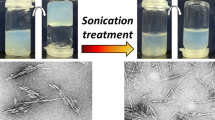Abstract
The objective of this study was to investigate the impact of nucleation temperature (T n) and excipient concentration on the collapse temperature data obtained from freeze-dry microscopy (FDM) experiments. T n, the temperature of the onset of collapse (T oc), and the full collapse temperature (T fc) were determined for aqueous solutions of polyvinylpyrrolidone (PVP) 40 kDa and 2-(hydroxypropyl)-ß-cyclodextrin. Concentrations were varied from 1% to 20% (w/w) for PVP and from 1% to 30% (w/w) for the 2-(hydroxypropyl)-ß-cyclodextrin. Mutual correlation coefficients were calculated for the observed T n, T oc, and concentrations of the solutions. In addition, outliers were detected and eliminated by applying the leaving-one-out routine and calculating correlation coefficients without it. T n was found to be non-correlated with concentrations and only weakly correlated with T oc. The correlation between these two temperatures was particularly poor for the solutions of the highest and lowest concentrations. In contrast, T oc correlated much better with the corresponding concentrations, resulting in a quadratic fit for PVP and a linear fit for 2-(hydroxypropyl)-ß-cyclodextrin.








Similar content being viewed by others
References
Franks F. Freeze-drying of bioproducts: putting principles into practice. Eur J Pharm Biopharm. 1998;45:221–9.
Abduhl-Fattah A, Kalonia DS, Pikal MJ. The challenge of drying method selection for protein pharmaceuticals: product quality implications. J Pharm Sci. 2006;96(8):1886–916.
Schwegman J, Hardwick L, Akers M. Pratical formulation and process development of freeze-dried products. Pharm Dev Tech. 2005;10:151–73.
Pikal MJ, Shah S. The collapse temperature in freeze drying: dependence on measurement methodology and rate of water removal from the glassy phase. Int J Pharm. 1990;62:165–86.
Passot S, Fonseca F, Alarcon-Lorca M, Rolland D, Marin M. Physical characterization of formulations for the development of two stable freeze-dried proteins during both dried and liquid storage. Eur J Pharm Biopharm. 2005;60:335–48.
Bellows RJ, King CJ. Freeze-drying of aqueous solutions: maximum allowable operating temperature. Cryobiology 1972;9:559–61.
Passot S, Fonseca F, Barbouche N, Marin M, Alarcon-Lorca M, Rolland D, et al. Effect of Product temperature during primary drying on the long-term stability of lyophilized proteins. Pharm Dev Technol. 2007;12:543–53.
Meister E, Gieseler H. Evaluation of collapse temperatures by freeze-dry microscopy: impact of excipient concentration on measured transition and the overall dependence on measurement methodology. Proc. 5th World Meeting on Pharmaceutics and Pharmaceutical Technology, Geneva, March 27–30, 2006.
Searles J, Carpenter J, Randolph T. The ice nucleation temperature determines the primary drying rate of lyophilization for samples frozen on a temperature-controlled shelf. J Pharm Sci. 2001;90(7):860–71.
Searles J. Freezing and annealing phenomena in lyophilization. In: Rey L, May J, editors. Freeze-drying/lyophilization of pharmaceutical and biological products. New York: Marcel Dekker; 2004. p. 109–45.
Fonseca F, Passot P, Cunin O, Marin M. Collapse temperature of freeze-dried lactobacillus bulgaricus suspensions and protective media. Biotechnol Prog. 2004;20:229–38.
Meister E. Methodology, data interpretation and practical transfer of freeze-dry microscopy. PhD Thesis, University of Erlangen-Nuremberg, Erlangen, Germany, 2009.
Vandenginste BGM, Massart DL, Buydens LMC, de Jong S, Lewi PJ, Smeyers-Verbeke J. Handbook of Chemometrics and Qualimetrics B, vol 3. Amsterdam: Elsevier; 1998. p. 87–160.
Rambhatla S, Ramot R, Bhugra C, Pikal MJ. Heat and mass transfer scale-up issues during freeze drying: II. Control and characterization of the degree of supercooling. AAPS PharmSciTech. 2004;5(4), e58:1–9.
Pikal MJ. Freeze drying. In: Swarbrick J, Boylan JC, editors. Encyclopaedia of Pharmaceutical Technology. New York: Marcel Dekker; 2002. p. 1299–326.
Pikal MJ, Costantino HR. Lyophilization of biopharmaceuticals. In: Borchardt RT, Middaugh CR, editors. Biotechnology: Pharmaceutical Aspects. Arlington: AAPS; 2004. p. 113–38.
Miyata K, Kanno H. Supercooling behavior of aqueous solutions of alcohols and saccharids. J Mol Liquids 2005;119:189–93.
Author information
Authors and Affiliations
Corresponding author
Rights and permissions
About this article
Cite this article
Meister, E., Šaši, S. & Gieseler, H. Freeze-Dry Microscopy: Impact of Nucleation Temperature and Excipient Concentration on Collapse Temperature Data. AAPS PharmSciTech 10, 582–588 (2009). https://doi.org/10.1208/s12249-009-9245-y
Received:
Accepted:
Published:
Issue Date:
DOI: https://doi.org/10.1208/s12249-009-9245-y




